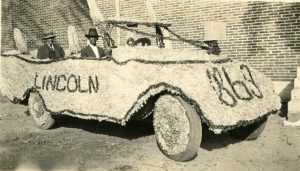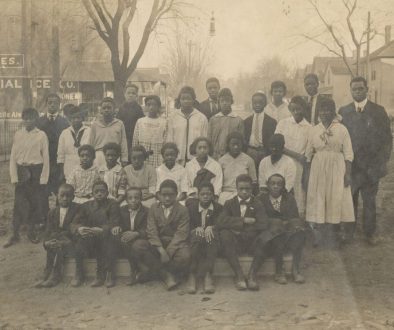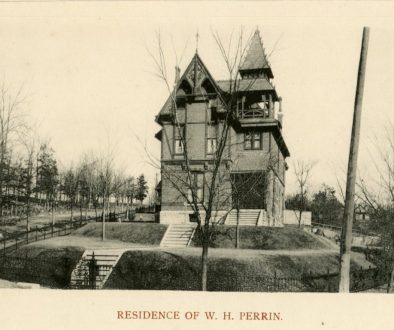Emancipation Day – September 22
By Mary E. Anthrop
In the latter part of the 19th century and well into the 20th century Lafayette’s African American population celebrated September 22 as Emancipation Day. September 22 was the anniversary of President Abraham Lincoln’s issuance of the preliminary Emancipation Proclamation (September 22, 1862). Lafayette’s African Americans celebrated Emancipation Day with social festivities – memorial programs, daytime picnics or barbecues with athletic competitions and evening activities with socializing, dancing and vocal and instrumental performances. Whether the activities were large community pageants, informal school recitations, or club and church events, they fostered racial pride and patriotism. These commemorations provided an opportunity for both the white and black communities to reflect on the progress and challenges in racial relations since the end of slavery.
On the 50th anniversary in 1913 the Lafayette Daily Courier explained to its readers the significance of Lincoln’s decision to free the slaves in the Southern states in rebellion. Emancipation was not the immediate objective of the Civil War. As Lincoln believed preserving the Union was his greater consideration, he could neither alienate the abolitionists nor the Union slave holders in the border states. In the ensuing course of the War, however, Lincoln saw emancipation not only as morally right, but a necessary war measure. He announced to his cabinet in July, 1862, his emancipation policy. Emancipation would come after the first great Union victory. On September 17, 1862 the Union army sent Confederate General Robert E. Lee into retreat at the battle of Antietam (Maryland). Less than a week later Lincoln on September 22, 1862 issued the preliminary proclamation. The proclamation would go into effect on January 1, 1863. “All persons held as slaves in any state, the people whereof shall be in rebellion against the United States, shall be then, thenceforward, and forever, free.”[1]
The Emancipation Day anniversary celebrations varied in formal and informal gatherings from year to year with the larger and more elaborate events taking place between 1880 and 1916. The 1920s and 1930s frequently saw smaller observances in homes and churches. No one place staged the annual celebrations. The Tippecanoe County fairgrounds, Linnwood Park, Columbian Park, Murdock Park and Barbee’s Grove hosted the large daytime picnics and barbecues. Attendees at the large celebrations easily numbered in the hundreds and included invited guests from Logansport, Attica, Danville, Delphi, Crawfordsville, Lebanon, Shelbyville and Indianapolis.
A street parade led by a local band initiated the large social festivities. Organizers, often one or more of the local lodges – Odd Fellows, Knights Templar and Knights of Pythian, asked residents to display the “national colors” and decorations along a downtown parade route. The subsequent programs to commemorate the significance of the holiday included prayers, vocal selections, readings and addresses. Local distinguished guests, often Civil War veterans, like Colonel James Tullis, Colonel R. P. DeHart or Col. W. C. Wilson, read the Emancipation Proclamation or shared their perspectives on racial progress. Visiting ministers from Indianapolis or Crawfordsville also addressed the crowds. Messages were usually optimistic and congratulatory on economic and political accomplishments since slavery days. Smaller programs, such as the ones conducted at the black Lincoln School, mirrored the same tone of hopefulness in the future of the black race in the United States. In 1899 and 1903 W.F. Anderson, principal of Lincoln School, organized programs in which his pupils read selections by African American authors, sang patriotic songs, and listened to inspirational addresses. On display at the 1899 event were a variety of books, newspapers, and sheet music composed by African Americans. The Lafayette Daily Courier commented on Anderson’s efforts. “Mr. Anderson takes advantage of all such occasions to teach his children race pride and patriotism.”[2]

After sharing a picnic lunch and listening to appropriate memorial exercises, guests at afternoon activities enjoyed foot races and baseball games. Evening socials took place at the Blue Ribbon Hall, Pythian Hall and St. Joseph/Columbian Hall in downtown Lafayette. Refreshments, musical performances and dancing characterized the nighttime activities. Cakewalks (originally a slave dance mimicking flamboyant southern plantation owners) attracted enthusiastic participants and were often the main feature of the evening’s festivities. An 1885 Lafayette Daily Journal account, “Freemens’ Joy,” testified to the popularity of the cakewalk. The article detailed the scrutiny of the judging process, the agility of the attractive dancers and the excitement of an appreciative assembly. Judges chose an inter-racial couple, Richard Sample and Miss Rawlins, in 1885 as the most graceful couple and awarded them the prize cake.[3]
The celebration on the 50th anniversary of the issuance of the Emancipation Proclamation in 1913 particularly impressed the local Lafayette community. The Lafayette Daily Courier described it: “The colored people left nothing undone to make Emancipation day an enjoyable affair, and they succeeded most admirably.” [4] The event featured an elaborate street parade, a large barbecue at the fairgrounds, and an evening drama, “Fifty Years of Freedom,” at the Victoria theatre.
The street parade was “… a very creditable one, that revealed the enterprise and cleverness of those who arranged it.”[5] The Crawfordsville Knights of Tabor band, dressed in blue trousers, white hats, and white coats, and the Lafayette Lodge of Pilgrim Knights led the parade. Local and visiting guests rode in decorated buggies, automobiles and on attractive floats. Four young women dressed in white rode in a white trimmed float entitled “Ethiopia.” The most impressive floats – “Past, Present and Future,” according to the Daily Courier, depicted the history and future of the black race in the United States. The “Past” was a slave driving a dilapidated wagon. The “Present” were attractively attired young women riding in a touring car and the “Future” was a float trimmed in patriotic colors carrying a large number of Lincoln School children waving small American flags.
The barbecue, the roasting of a large pig and three sheep, at the fairgrounds attracted a large crowd in the afternoon. In addition to the local black population guests came from Crawfordsville, Gary, Frankfort, Indianapolis, Fowler, Fort Wayne and Danville and Champaign, Illinois. Speakers, likewise, represented these various cities. The main speaker, a former resident, Rev. M. W. Parks, reviewed the progress of the black race in the last half of the 19th century. The Lafayette Daily Courier, reported: “His address was eloquent and greatly pleased the crowd.”[6] A number of ex-slaves were present for the celebration, including John Fields, John Calicot and Marcus Edwards. Highlights in the afternoon athletic recreations included foot and motorcycle racing, greased pig chases and a baseball game between Lafayette and Fowler teams.
The climax of the festivities was the evening drama, “Fifty Years of Freedom,” at the Victoria theatre sponsored by the men and women of the Pilgrim Knights of the World. There was a large cast of local talent. The play followed the efforts of a young black man attempting to succeed in the world. He struggles against the prejudices of whites, but in the end he overcomes racial bigotry to the delight of his family. A mix chorus of men, women and girls also sang spirituals between acts. The Lafayette Daily Courier reviewed the play: “The dramatic production last evening was well worth witnessing and was greatly appreciated by the large audience composed of both colored and white people…. There were many stirring scenes in the play, and some fine acting was done.”[7]
Throughout the late 19th century and into the 20th century the Lafayette Daily Courier and the Lafayette Daily Journal routinely published reports of the annual Emancipation Proclamation activities. The accounts provided ample evidence of the celebratory characteristics of the commemorations. Unfortunately newspaper editorials and verbatim quotes of the addresses were infrequent. Determining the perception by black and white participants of the characteristics of black advancement since slavery is challenging.
Editorials in the Lafayette Daily Courier in 1879 and in 1913 both denounced slavery. In 1879 the editorial described slavery as a “national crime and disgrace” and measured progress by the knowledge that only a few years before advocates of emancipation were mobbed both in the North and the South. The writer saw advancement in the areas of the “progressive” South. He wrote: “… their former slaves, ambitious to advance and for the advancement of their children, make rapid progress in the industrial arts, and are fast freeing themselves from the shackles of lust and dishonesty, engendered and fostered by slavery.” [8]
Thirty-four years later in 1913, the 50th anniversary of the Emancipation Proclamation, another Lafayette Daily Courier editorial also condemned slavery, but provided no reflective analysis. The writer believed “ a race that holds another race in bondage must in the end pay…. Slavery debases the master as well as slaves.”[9] Although not a speech delivered as an Emancipation Day address, a speech in 1911 by Alva O. Reser, a Lafayette politician, provided a contemporary white perspective of black advancement since slavery. Reser addressed the annual picnic of the AME and Baptist congregations. (Colonel DeHart, a frequent speaker at Emancipation Day celebrations, hosted the gathering of over 300 people on his grounds along the Wabash River. Mayor George Durgan and Rev. M.W. Sparks, past Emancipation Day guests, also addressed the crowd). Reser was hopeful of the future progress of the black race. He argued that northern blacks possessed more civil and political rights than their southern brethren. He gave this advice: “Give your children a good common school education, and then manual training. The success of your race must be along the line of the mechanical trades…. The leaders of your race, and especially your churches, should be engaged in developing your race along physical and moral and industrial lines.”[10] Reser believed that the best thinkers of both the white and black races shared this advice of Booker T. Washington.
The newspapers do not record if the black orators at Lafayette’s Emancipation Day celebrations promoted the restrictive and controversial advice of Booker T. Washington. The efforts of the black lodges in the planning, preparation and implementation of successful community celebrations, however, testified to a determined and resourceful population. Their voices seen in the float of Lincoln School children waving American flags and found in the plot of “Fifty Years of Freedom,” spoke of a hopeful future. Lafayette’s black population saw themselves and their children conquering social prejudices and economic and political discrimination. In these formal and informal, large and small Emancipation Day celebrations the black community claimed a place in the country’s history.
[1] “Emancipation Day,” Lafayette Daily Courier, September 17, 1913.
[2] “Emancipation Day Exercises,” Lafayette Daily Courier, September 22, 1903.
[3] “Freemens’ Joy,” Lafayette Daily Journal, September 23, 1885.
[4] “Emancipation Day is Celebrated in City,” Lafayette Daily Courier, September 17, 1913.
[5] Ibid.
[6] Ibid.
[7] “Colored Folks in Drama, ‘Fifty Years of Freedom,’ is Well Presented,” Lafayette Daily Courier, September 18, 1913.
[8] “Emancipation Day,” Lafayette Daily Courier, September 17, 1879.
[9] “Emancipation Day,” Lafayette Daily Courier, September 17, 1913.
[10] “Colored People at Outing Enjoy Talks,” Lafayette Daily Courier, August 17, 1911.



